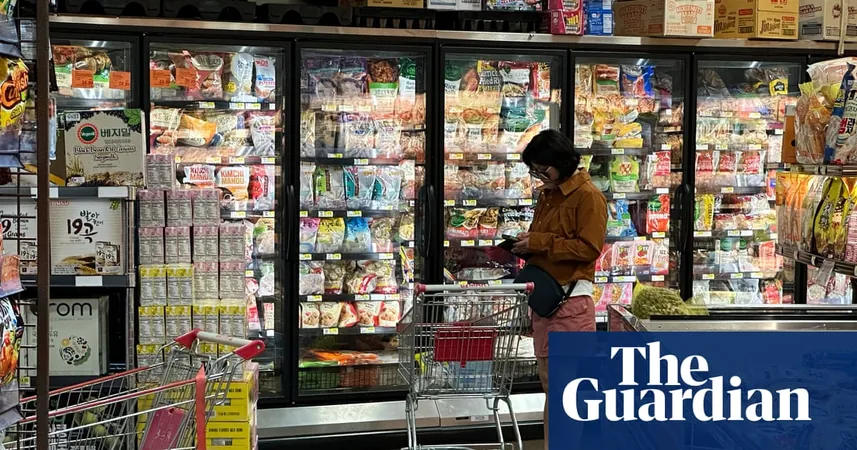
Is Stagflation Looming Over the U.S. Economy? Experts Point to Trump’s Policies as Culprits!
2025-09-13
Author: Kai
A Potential Economic Crisis on the Horizon?
The U.S. economy is currently traversing a paradoxical landscape: prices are climbing, job growth appears stagnant, and stock markets are hitting unprecedented heights. Amid this peculiar mix, a daunting term from the 1970s—stagflation—has resurfaced in economic discussions.
What Is Stagflation?
Stagflation refers to the troubling combination of stagnant economic growth and rising inflation, where companies cut back on hiring and production, yet consumers face soaring prices. This scenario is considered by some economists to be even more dire than a traditional recession.
A Historic Comparison
The last significant instance of stagflation in the U.S. occurred during the 1970s oil crisis when skyrocketing oil prices fueled inflation while simultaneously pushing unemployment rates higher as consumer spending waned.
Current Economic Signs
While the U.S. economy hasn't yet entered stagflation territory, recent data indicates a creeping approach towards it.
Initially, after Donald Trump proposed tariffs in the spring, the economy seemed resilient with stable job additions and a drop in inflation to 2.3%, the lowest since 2021. However, recent labor market updates from August revealed surprising downward revisions, indicating a painful hit to job creation that surfaced only later.
Inflation’s Comeback
Simultaneously, inflation made a comeback this April, culminating in a yearly rate of 2.9% by August—the highest since January.
Economic Forecasts Turned Upside Down
Brett House, an economist at Columbia Business School, highlighted a stark shift in expectations. Back in January, economists projected solid growth with easing inflation; however, policy shifts and inconsistent implementation have reversed these predictions.
"We've seen growth forecasts slashed, while inflation estimates have surged," House commented. Essentially, the economy has become both stagnant and inflationary—steering dangerously close to stagflation.
The Policies at Play
Expert economists are zeroing in on two key Trump-era policies driving this economic tension: his stringent immigration policies, which have shrunk the labor pool and inflated hiring costs, and the imposition of tariffs, whose effects have begun manifesting as companies transfer burdensome costs onto consumers.
The Federal Reserve's Dilemma
Investors are hopeful that the Federal Reserve may lower interest rates soon, yet the overall economic outlook remains hazy. Jerome Powell, the Fed chair, recently acknowledged a complex balance in the labor market, where both supply and demand for workers have slowed, as higher tariffs continue to elevate prices in some goods categories.
The Fed's Limited Options
Stagflation constrains the Fed's ability to manage the economy effectively. Adjustments to interest rates typically target either unemployment or inflation; however, both struggle under stagflation. In 2022, with inflation peaking at 9.1%, interest rate hikes tempered prices but left rising unemployment in their wake.
Could Stagflation Become a Reality?
While stagflation hasn't fully emerged, lowering rates could improve the job market without triggering rampant price increases. But, looming risks remain. Economist Sebnem Kalemli-Ozcan warned, "If stagflation is creeping in, firms may start passing tariff costs onto more consumers as demand strengthens, which will ignite inflation further."
Consumer Costs Are Climbing
Goldman Sachs projected that consumers absorbed about 22% of tariff costs, potentially escalating to 67% if current tariffs remain in place. Continued rising prices coupled with a slowing labor market could mean stagflation becomes a more pressing concern.
The Fallout from Stagflation
Should stagflation set in, the scenario would be particularly grim: increased job losses alongside higher unemployment rates would make job searches exceedingly difficult for many.
The Yale Budget Lab estimates that Trump’s tariffs could elevate poverty levels by at least 650,000 Americans, framing these tariffs as an indirect tax.
A Call for Patience?
Despite the growing evidence of economic strain, the Trump administration has urged U.S. citizens to remain patient regarding tariff impacts, suggesting recent data is biased against the former president. Trump himself remarked, "The real numbers will come, but they will be evident a year from now, and we will see job figures like never before."


 Brasil (PT)
Brasil (PT)
 Canada (EN)
Canada (EN)
 Chile (ES)
Chile (ES)
 Česko (CS)
Česko (CS)
 대한민국 (KO)
대한민국 (KO)
 España (ES)
España (ES)
 France (FR)
France (FR)
 Hong Kong (EN)
Hong Kong (EN)
 Italia (IT)
Italia (IT)
 日本 (JA)
日本 (JA)
 Magyarország (HU)
Magyarország (HU)
 Norge (NO)
Norge (NO)
 Polska (PL)
Polska (PL)
 Schweiz (DE)
Schweiz (DE)
 Singapore (EN)
Singapore (EN)
 Sverige (SV)
Sverige (SV)
 Suomi (FI)
Suomi (FI)
 Türkiye (TR)
Türkiye (TR)
 الإمارات العربية المتحدة (AR)
الإمارات العربية المتحدة (AR)